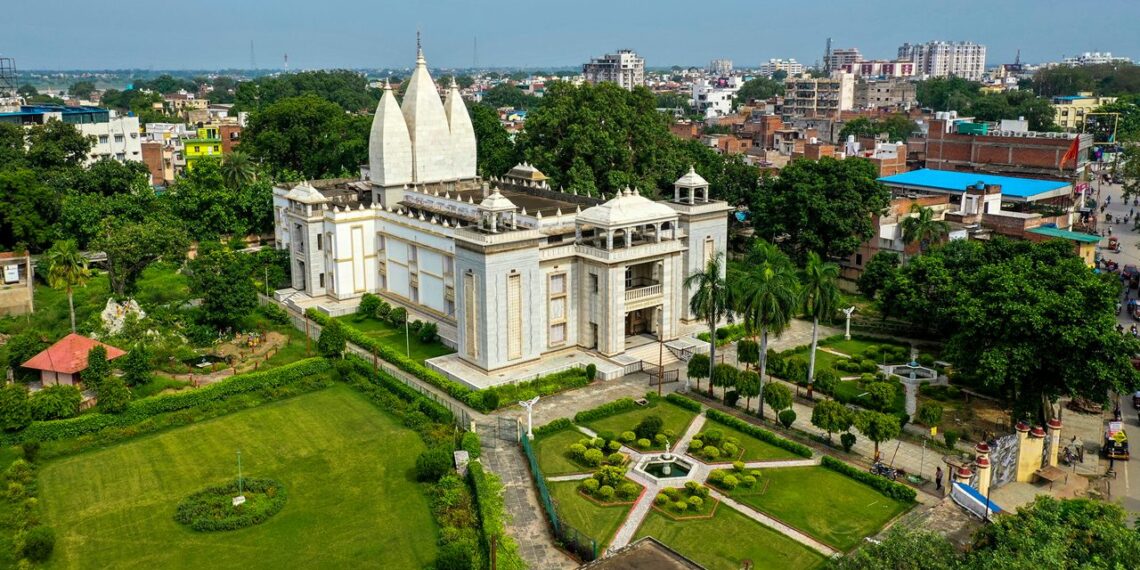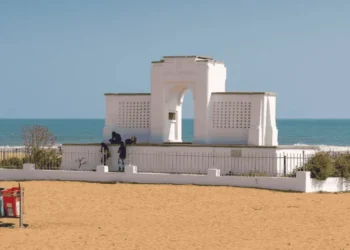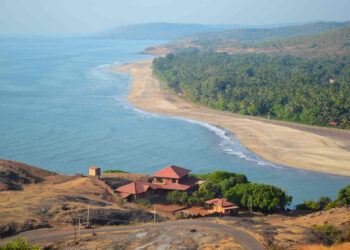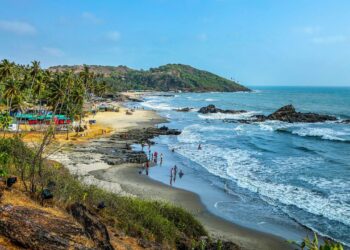In Varanasi, Uttar Pradesh, near the Ganga River in the Durgakund area, the Tulsi Manas Temple is a sacred place where people come to worship Lord Rama. This temple holds deep historical and cultural significance in Hinduism, as it is the very place where the revered poet-saint, reformer, and philosopher Goswami Tulsidas composed the ancient Hindu epic Ramcharitmanas in the 16th century (1532–1623).
History of Tulsi Manas Temple
The Tulsi Manas Temple was built in 1964 by the Birla family, known for making many temples. Varanasi, tied to Lord Shiva and Lord Rama in the Ramayana, is a sacred city in Hindu tales. Local talk says the temple was made to honor Goswami Tulsidas, who wrote the Ramcharitmanas here in the 16th century. They say Tulsidas sat at this spot, near Assi Ghat, to pen his epic on Rama’s life. Records note the temple’s link to the Ramcharitmanas, mentioned in the Skanda Purana’s Kashi Khanda.
The temple is situated on a level piece of land, accessible by ten stone steps. In the 1800s, British travelers recorded its association with Tulsidas. After India’s independence in 1947, the state trust assumed responsibility for its upkeep. Restoration efforts in the 1990s preserved its original appearance. For centuries, saints have sung praises of Lord Rama here, spreading its fame. Today, countless devotees visit this sacred site in Varanasi.
Legends of Tulsi Manas Temple
One of the legend says Tulsidas saw Lord Rama here in a vision, inspiring him to write the Ramcharitmanas. Devotees believe Rama’s presence is palpable in the temple, and praying here with a true heart brings blessings and takes away troubles, as Rama is known for his truth in the Ramayana.
According to another legend, it was at this very place that Tulsidas met Lord Hanuman, who guided him to compose the epic of Ramayana. Some also believe that a neem tree near the temple carries the divine presence of Lord Rama. These stories, passed down through generations, continue to draw pilgrims seeking the blessings and presence of Rama.
Another belief holds that reciting the Ramcharitmanas seven times at this temple can bring peace of mind, courage, and success in overcoming challenges. Others claim the temple’s air carries Rama’s protective power, making it a place of divine care. During Ram Navami, devotees believe Hanuman from the nearby Sankat Mochan Temple, 1 kilometer away, visit the temple to pay his homage to Rama.
Architecture of Tulsi Manas Temple
The Tulsi Manas Temple sits on two acres near Durgakund, made in a simple North Indian style. The main part has a white marble top, carved with Rama’s bow, arrows, and lotus, all in white stone. Inside, the Rama idol, 5 feet tall and covered in yellow paste, stands with a bow in his right hand and Ma Sita by his side. A 3-foot idol of Lakshman, his brother, is nearby, lit by oil lamps.
A small hall inside the temple is supported by six stone pillars, each carved with scenes from the Ramcharitmanas. In the marble courtyard, there are smaller shrines dedicated to Sita, Hanuman, and Shiva. The shrine of Ma Sita shows her holding a lotus, symbolizing love. The Hanuman shrine, built in 1964, depicts him with a mace, representing strength and valor. The Shiva shrine houses a lingam, a symbol of Brahman. The marble courtyard feels sacred, lying close to the Ganga River. A simple gate at the entrance bears the face of Lord Rama. About two kilometers away, a water ghat on the Ganga’s edge offers a place for ritual baths. The temple walls are engraved with verses from the Ramcharitmanas in Hindi, guiding devotees in prayer. A peaceful garden with a neem tree adds to the calmness of the place.
Rituals and Festivals
The temple stirs for festivals. Ram Navami, in April, is big, with all-day chants and milk pujas. Tulsidas Jayanti, in August, honors the saint with lamps. Diwali, in October or November, sees daily idol baths with water.
Ram Navami’s chants fill the yard with faith. Devotees offer coconut, yellow cloth, tulsi leaves, and marigold flowers. Some chant the Ramcharitmanas nine times, taking 4 hours, for special wishes. Charity meals feed 3,000–7,000 during festivals.
Information for Travelers
Hours and Entry: Open every day, 5:00 AM to 12:00 PM and 3:00 PM to 9:00 PM. It’s free to enter. No pictures in the inner room.
Clothing: Wear clothes covering shoulders and knees. Women for prayers wear sarees or suits, men wear kurtas.
How to Get There:
Air: Varanasi Airport, 25 km away, connects to Delhi (1.5 hours) and Mumbai (2 hours). Taxis take about 45 minutes.
Train: Varanasi Junction, 5 km away, connects to Delhi (12 hours) and Lucknow (6 hours). Autos available.
Road: Varanasi is 300 km from Lucknow on NH 27. Buses and autos are available from the city center. Parking is available for vehicles.
Best Time to Visit:
October to March is cool, 15–25°C. Weekdays are quiet. Ram Navami’s full, with 10,000–30,000 devotees, so plan early.
Nearby Attractions:
Sankat Mochan Temple: 1 km away, a Hanuman shrine from the 16th century.
Durga Temple: 0.5 km away, a Durga shrine from 1700.
Kashi Vishwanath Temple: 4 km away, a Shiva shrine, a Jyotirlinga.
Assi Ghat: 2 km away, a bath spot for prayers.
Final Words
The Tulsi Manas Temple is a place where history, devotion, and culture come together in the heart of Varanasi. Whether visiting during festivals or in quiet moments, one leaves the temple with a sense of spiritual renewal and a deeper appreciation for Varanasi’s sacred heritage.











